behold_a_man
Educated
- Joined
- Nov 26, 2022
- Messages
- 144
I finished the Pools of Darkness:
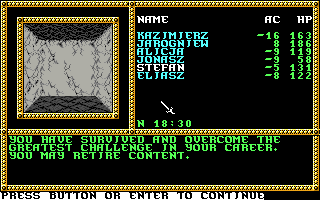
And what I noticed:
1) About Exploration:
a) Environments in this game were diverse, sometimes memorable - like Moander's body (especially his heart) or Dark Phlan.
b) Each auxiliary place was properly developed; four fully-fledged locations were built around sidequests (Myth Dranor, Silver Blades Cave, Temple of Tyr, Stockade); Minor sidequests were placed statically (unlike in Pool of Radiance) and somewhat interesting (giving me the ability to rest among other things - unlike in Curse and Radiance).
c) Kaliste's land showcases the widely praised tricks used in Silver Blades:
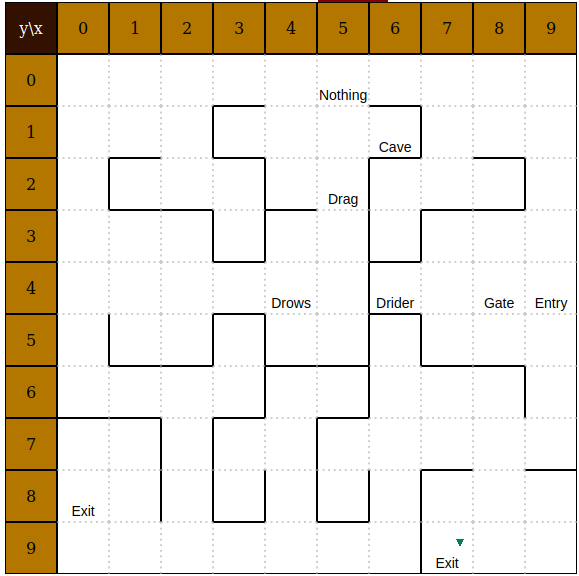
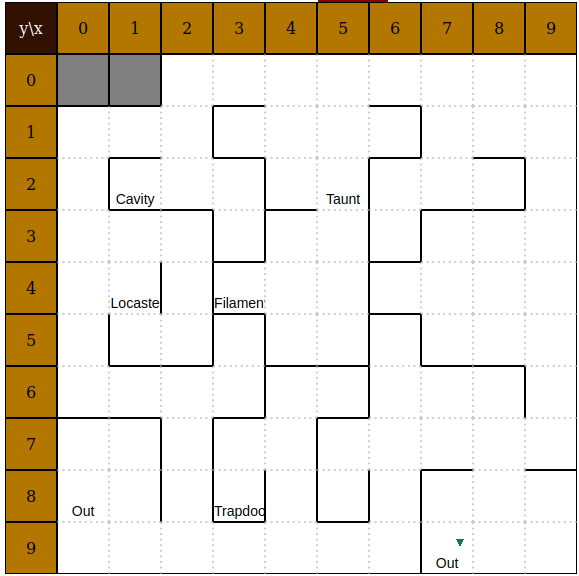
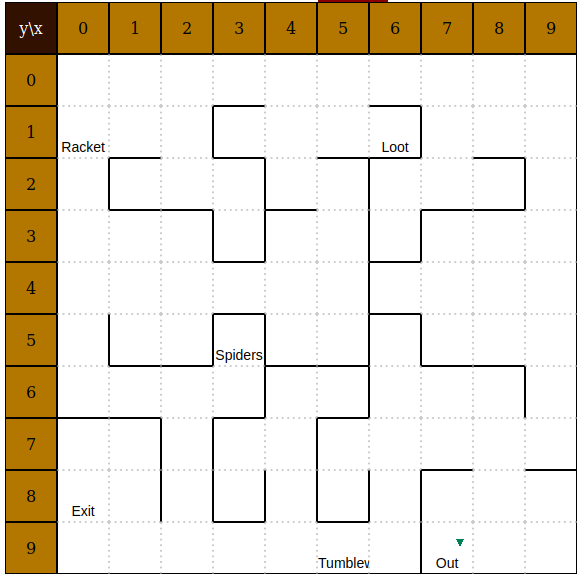
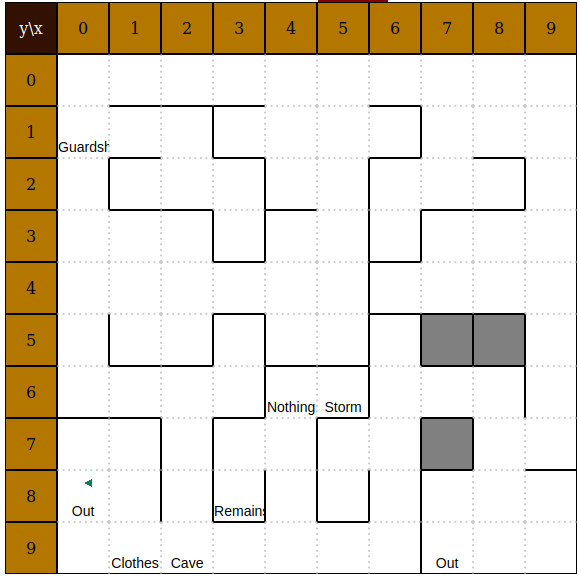 Note that I didn't bother to map them fully - the game even communicates, after finding all the unique events in one of those nothingplaces, that
Note that I didn't bother to map them fully - the game even communicates, after finding all the unique events in one of those nothingplaces, that
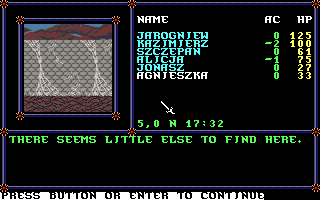 . To make things worse, two of them only contained some not-so-special equipment.
. To make things worse, two of them only contained some not-so-special equipment.
d) It's nice to see a game changing its environment after beating the almost final boss (overworld map changes; all places get some additional description; Mulmaster gets an overhaul).
e) The game was pretty nonlinear - I could tackle problems in any order I saw fit, and I could always backtrack to safety. One caveat: I could not leave the land past the pool of darkness without losing stuff; but I could still rest freely, so it was not a huge handicap.
f) Having to switch equipment past the pool of darkness was a logical decision from my perspective, given I already had almost optimal equipment in the previous title, and it was one of the few ways to make encounters anyhow rewarding.
2) Concerning writing, story, and so on:
a) My actions did have some consequences; for example, those situations happen if:
->
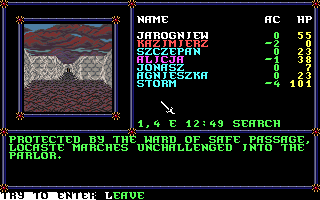
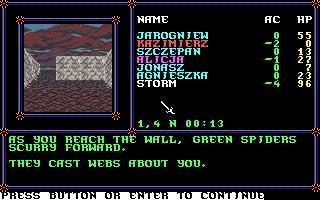
->
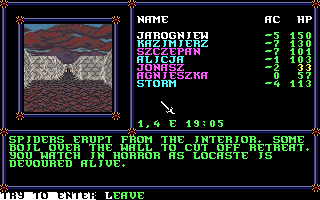
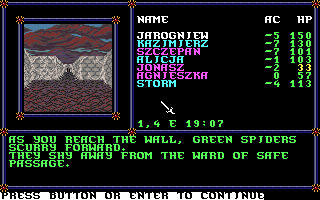
A similar thing goes for exploring Moander's body and getting the drug or carelessly strolling around Thorne's land before confronting him. I like the amorphic character of those decisions, how wildly different their consequences were.
b) The journal had some implications for the gameplay this time, even if relatively minor - I had to answer the question in Kalistes' Temple using the information from a journal; and this interaction is remarkable:
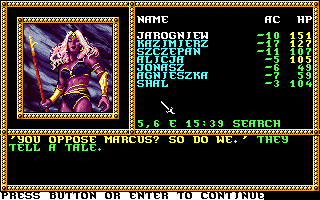
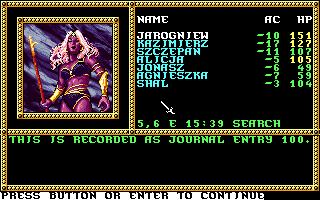
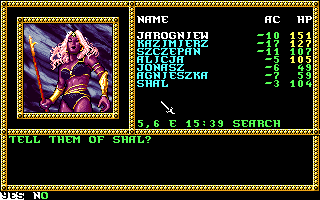
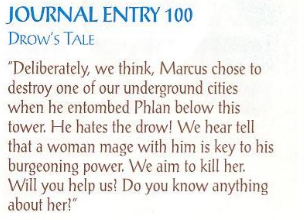
It's fun to think about this conversation if someone did defer reading the journal in this case.
- We want to kill X, do you know about X's whereabouts?
- Sure, we have X in our party.
c) I liked the organic way of indicating rest-safe places - like
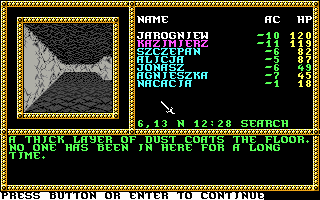 .
.
d) Enemy spawning places usually made sense - for example, in the Red Tower, in a dome engulfed in cold, no one dared to bother me or interrupt my rest.
e) There were fewer jokes than in Silver Blades, but those two were pretty nice:
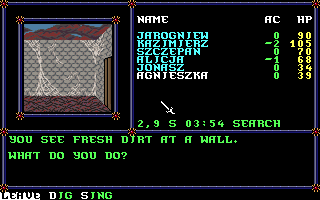
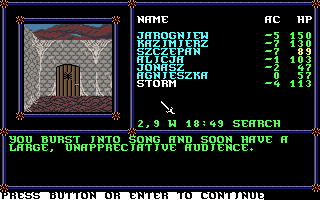 and
and
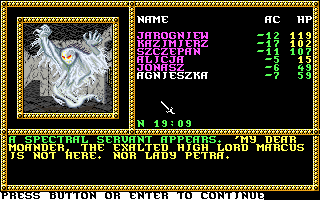
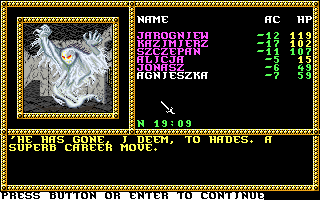 .
.
3) Visually, the game is pretty. It's nice they reworked monster icons - not that they were ugly earlier, but looking at them through three games was starting to wear me down. The interface improved quite a bit - the game remembers previously memorized spells, and the game shows characters able to level up in a different color.
4) The game is focused on combat, though. What would I expect from a game focused on combat?
a) Proper documentation - I had to use external resources to get all the interesting data about the benefits of level-ups and (what follows) when to dual-class; also, the manual (and journal) didn't give me a definite answer on which classes are bad (and won't get better). It's quite a problem, given that the endgame seems to be built around very intense powergaming.
b) The ability to develop character as I see fit - Here, there is pretty much a single choice for any character I make: when to dual-class. And I have to wait for ~half the game to really see the results if I dual at level ~20, which, if I'm not mistaken, is optimal given the progression of Thac0 and saving throws.
c) Plethora of abilities or different ways of fighting - Here, half of the singular classes felt handicapped in combat. Fighters and thieves had very few options, clerics were simplistic, and most mages' spells were subpar.
d) Diverse challenges - The game did relatively well in that aspect, though everything got repetitive in the end (since the disposal of the third lieutenant, the only not-so-new enemies were beholders and extraordinarily weak snakes).
e) Rewards for combat - Except for what awaited me within pools, loot was almost non-existent. Thankfully, experience boosts got very significant in this game; but the difference between having a level 25 fighter and a level 35 fighter was barely visible, except for several very specific fights. It could be more meaningful with dual-classing though.
f) Somewhat capable AI - oh well, in this game, pathfinding seems randomized(?) - If my character is behind the wall, enemies usually won't get to it, they will stroll randomly until they'll get close enough to process the ability to get to my character. It leads to some special tactics - take, for example, the beholder fight in the palace of a bad lieutenant (the minor one): There are four beholders, surrounded by some salamanders and margoyles. How to get my melee units to whack beholders before they get to unleash their wicked attacks?
-> Move everyone to a small room below.
-> Wait until some gargoyles get there and pick them one by one.
-> At some point, all units will go to the outer wall by the room - except for slow beholders.
-> Then, hastened warriors can quickly remove exposed beholders (it took me two turns).
Additionally,
- Difficulty levels are scuffed - the difference between them boils down to monsters' HP and (if I'm not mistaken) the damage they deal. Given that winning a battle is mostly dependent on initiative (and winning a war relies on knowing places where I can rest), lowering it helps only in a small subset of fights. Ultimately, I played everything excluding the triple fight and the start of the game on 'champion'.
- I liked that a lot of places didn't have random encounters, and even if they were present, those skirmishes seemed much sparser than in Curse.
- The balancing of combat was insane; if I play the entire game with the same team with minor problems, I expect that team to be able to beat the final boss after some attempts, not to be unable to even finish the second fight without my characters becoming one with nothing. In the end, I lowered the difficulty to the lowest one, still needing quite a lot of reloading. Only during Dave's quest did I figure out that it might be better to have a default level 14 fighter than a max level thief or an illiterate cleric - especially given that I already had a paladin.
5) Potentially the most interesting thing in the entire game was the Dave's Challenge. Unlike the rest of the game, it explicitly expected swapping party members throughout the dungeon. It's a shame I could not really train my characters during the endgame - I tried dual-classing from fighter to cleric or mage, but I only managed to get to the 7th level in the second class until I exhausted my options before going to the dungeon - and within the dungeon, I can only level up four times, for, just like before, I can only level up once during a single training session, and after that, all the remaining experience goes down the drain. What follows, I couldn't really test any interesting builds there, if I didn't use dual-classed characters already. The last pair of fights was pretty simple with a properly assembled team. Also, how was I supposed to guess the 'mystic clue' at the end of a dungeon? I went through all my screenshots in the dungeon and tinkered with any possible password, only to learn (from external sources) that it was all a ?ruse?. The answer didn't make any sense to me (unless they wanted to sell cluebooks).
6) The game had a lot of frustrating bugs (or features, as they like to call them) - combat was oftentimes crashing (specifically, during the fight with the last lieutenant, I encountered multiple crashes, usually when I tried to summon monsters). Sometimes, rest didn't calculate the needed time properly. If your NPC is unconscious at the end of his quest, he won't acknowledge the end of his mission (which drove me nuts in Kalistes' dimension, as I thought I missed something; ultimately, I just restarted the last fight and got to the end of Storm's mission right after). After the death of Akram, strolling through the dungeon yielded multiple messages remarking that Akram was escaping through the dungeon. And, of course, clicking the Escape button during combat always places my character at the beginning of their walk, even if I have already whacked someone, without losing movement points.
To summarize, the scaffolding of the game (everything except combat) was done pretty much just as well as in Pool of Radiance; however, the game is focused on combat, I don't think the system they used is suitable for what they wanted to achieve, and Pools didn't convince me otherwise; the game wasn't helping either with its AI, unbalance, or the need for external sources to get all the information needed to figure out why certain things were harder than they should be. I have an urge to replay this game with a different party just for the endgame, but the main body of a game isn't that challenging, so I don't think I will.

And what I noticed:
1) About Exploration:
a) Environments in this game were diverse, sometimes memorable - like Moander's body (especially his heart) or Dark Phlan.
b) Each auxiliary place was properly developed; four fully-fledged locations were built around sidequests (Myth Dranor, Silver Blades Cave, Temple of Tyr, Stockade); Minor sidequests were placed statically (unlike in Pool of Radiance) and somewhat interesting (giving me the ability to rest among other things - unlike in Curse and Radiance).
c) Kaliste's land showcases the widely praised tricks used in Silver Blades:





d) It's nice to see a game changing its environment after beating the almost final boss (overworld map changes; all places get some additional description; Mulmaster gets an overhaul).
e) The game was pretty nonlinear - I could tackle problems in any order I saw fit, and I could always backtrack to safety. One caveat: I could not leave the land past the pool of darkness without losing stuff; but I could still rest freely, so it was not a huge handicap.
f) Having to switch equipment past the pool of darkness was a logical decision from my perspective, given I already had almost optimal equipment in the previous title, and it was one of the few ways to make encounters anyhow rewarding.
2) Concerning writing, story, and so on:
a) My actions did have some consequences; for example, those situations happen if:
->


->


A similar thing goes for exploring Moander's body and getting the drug or carelessly strolling around Thorne's land before confronting him. I like the amorphic character of those decisions, how wildly different their consequences were.
b) The journal had some implications for the gameplay this time, even if relatively minor - I had to answer the question in Kalistes' Temple using the information from a journal; and this interaction is remarkable:




It's fun to think about this conversation if someone did defer reading the journal in this case.
- We want to kill X, do you know about X's whereabouts?
- Sure, we have X in our party.
c) I liked the organic way of indicating rest-safe places - like

d) Enemy spawning places usually made sense - for example, in the Red Tower, in a dome engulfed in cold, no one dared to bother me or interrupt my rest.
e) There were fewer jokes than in Silver Blades, but those two were pretty nice:




3) Visually, the game is pretty. It's nice they reworked monster icons - not that they were ugly earlier, but looking at them through three games was starting to wear me down. The interface improved quite a bit - the game remembers previously memorized spells, and the game shows characters able to level up in a different color.
4) The game is focused on combat, though. What would I expect from a game focused on combat?
a) Proper documentation - I had to use external resources to get all the interesting data about the benefits of level-ups and (what follows) when to dual-class; also, the manual (and journal) didn't give me a definite answer on which classes are bad (and won't get better). It's quite a problem, given that the endgame seems to be built around very intense powergaming.
b) The ability to develop character as I see fit - Here, there is pretty much a single choice for any character I make: when to dual-class. And I have to wait for ~half the game to really see the results if I dual at level ~20, which, if I'm not mistaken, is optimal given the progression of Thac0 and saving throws.
c) Plethora of abilities or different ways of fighting - Here, half of the singular classes felt handicapped in combat. Fighters and thieves had very few options, clerics were simplistic, and most mages' spells were subpar.
d) Diverse challenges - The game did relatively well in that aspect, though everything got repetitive in the end (since the disposal of the third lieutenant, the only not-so-new enemies were beholders and extraordinarily weak snakes).
e) Rewards for combat - Except for what awaited me within pools, loot was almost non-existent. Thankfully, experience boosts got very significant in this game; but the difference between having a level 25 fighter and a level 35 fighter was barely visible, except for several very specific fights. It could be more meaningful with dual-classing though.
f) Somewhat capable AI - oh well, in this game, pathfinding seems randomized(?) - If my character is behind the wall, enemies usually won't get to it, they will stroll randomly until they'll get close enough to process the ability to get to my character. It leads to some special tactics - take, for example, the beholder fight in the palace of a bad lieutenant (the minor one): There are four beholders, surrounded by some salamanders and margoyles. How to get my melee units to whack beholders before they get to unleash their wicked attacks?
-> Move everyone to a small room below.
-> Wait until some gargoyles get there and pick them one by one.
-> At some point, all units will go to the outer wall by the room - except for slow beholders.
-> Then, hastened warriors can quickly remove exposed beholders (it took me two turns).
Additionally,
- Difficulty levels are scuffed - the difference between them boils down to monsters' HP and (if I'm not mistaken) the damage they deal. Given that winning a battle is mostly dependent on initiative (and winning a war relies on knowing places where I can rest), lowering it helps only in a small subset of fights. Ultimately, I played everything excluding the triple fight and the start of the game on 'champion'.
- I liked that a lot of places didn't have random encounters, and even if they were present, those skirmishes seemed much sparser than in Curse.
- The balancing of combat was insane; if I play the entire game with the same team with minor problems, I expect that team to be able to beat the final boss after some attempts, not to be unable to even finish the second fight without my characters becoming one with nothing. In the end, I lowered the difficulty to the lowest one, still needing quite a lot of reloading. Only during Dave's quest did I figure out that it might be better to have a default level 14 fighter than a max level thief or an illiterate cleric - especially given that I already had a paladin.
5) Potentially the most interesting thing in the entire game was the Dave's Challenge. Unlike the rest of the game, it explicitly expected swapping party members throughout the dungeon. It's a shame I could not really train my characters during the endgame - I tried dual-classing from fighter to cleric or mage, but I only managed to get to the 7th level in the second class until I exhausted my options before going to the dungeon - and within the dungeon, I can only level up four times, for, just like before, I can only level up once during a single training session, and after that, all the remaining experience goes down the drain. What follows, I couldn't really test any interesting builds there, if I didn't use dual-classed characters already. The last pair of fights was pretty simple with a properly assembled team. Also, how was I supposed to guess the 'mystic clue' at the end of a dungeon? I went through all my screenshots in the dungeon and tinkered with any possible password, only to learn (from external sources) that it was all a ?ruse?. The answer didn't make any sense to me (unless they wanted to sell cluebooks).
6) The game had a lot of frustrating bugs (or features, as they like to call them) - combat was oftentimes crashing (specifically, during the fight with the last lieutenant, I encountered multiple crashes, usually when I tried to summon monsters). Sometimes, rest didn't calculate the needed time properly. If your NPC is unconscious at the end of his quest, he won't acknowledge the end of his mission (which drove me nuts in Kalistes' dimension, as I thought I missed something; ultimately, I just restarted the last fight and got to the end of Storm's mission right after). After the death of Akram, strolling through the dungeon yielded multiple messages remarking that Akram was escaping through the dungeon. And, of course, clicking the Escape button during combat always places my character at the beginning of their walk, even if I have already whacked someone, without losing movement points.
To summarize, the scaffolding of the game (everything except combat) was done pretty much just as well as in Pool of Radiance; however, the game is focused on combat, I don't think the system they used is suitable for what they wanted to achieve, and Pools didn't convince me otherwise; the game wasn't helping either with its AI, unbalance, or the need for external sources to get all the information needed to figure out why certain things were harder than they should be. I have an urge to replay this game with a different party just for the endgame, but the main body of a game isn't that challenging, so I don't think I will.










